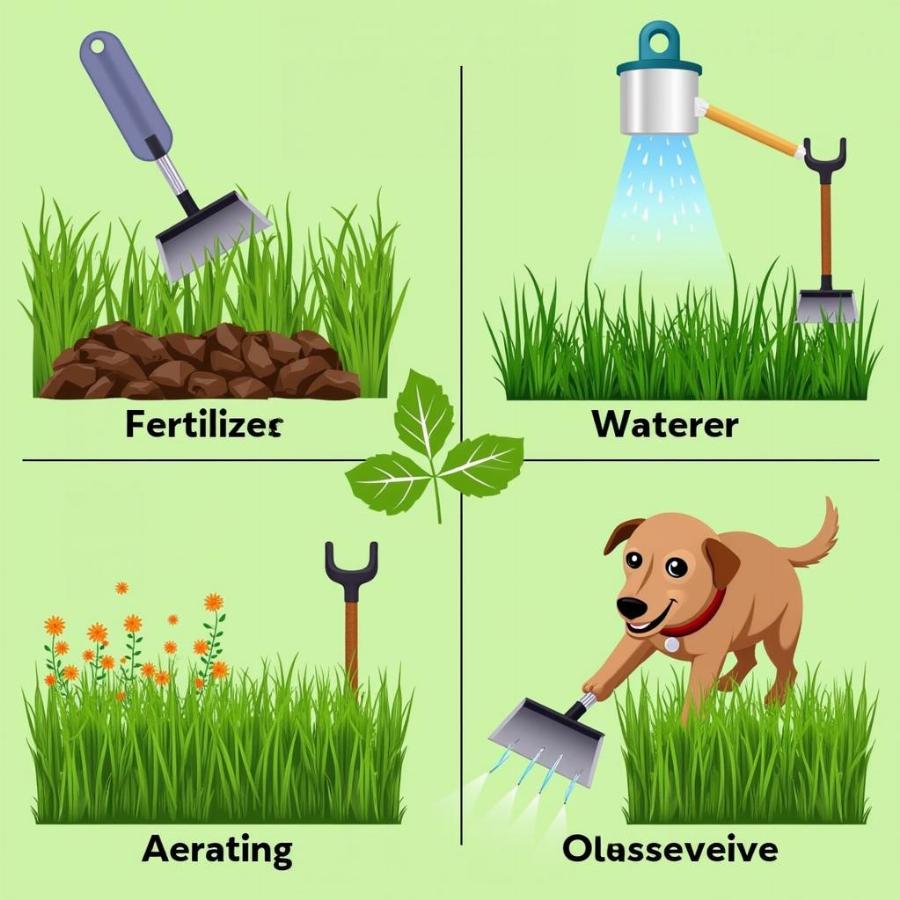Maintaining a lush, green lawn can feel like a constant battle when you have furry friends running around. Dog urine can create unsightly brown spots, and their playful digging and running can tear up the grass. This article will provide practical tips and solutions for how to grow a lawn with dogs, so you can enjoy a beautiful yard everyone can appreciate.
Choosing the Right Grass Type
The first step in creating a dog-friendly lawn is selecting a durable grass type. While no grass is completely immune to dog urine or wear and tear, certain varieties hold up better than others. Consider these options:
- Fescue: This cool-season grass is known for its tolerance to shade, drought, and heavy traffic, making it a good choice for active dogs.
- Bermuda grass: This warm-season grass is highly resilient and recovers quickly from damage, making it suitable for warmer climates.
- Ryegrass: A fast-growing cool-season grass, ryegrass can be a good option for overseeding existing lawns to fill in bare patches caused by dog activity.
Counteracting Dog Urine Spots
Dog urine contains nitrogen and salts, which can burn grass, leading to those infamous brown spots. Here are some strategies to combat this issue:
- Water the area: Immediately after your dog urinates, flush the area with plenty of water to dilute the urine and prevent it from damaging the grass.
- Train your dog to designated potty areas: Consider creating a designated area with a dog-friendly ground cover, such as gravel or mulch. This helps to contain urine damage to a specific area.
- Dietary adjustments: Consult with your veterinarian about potential dietary adjustments that may help reduce the concentration of nitrogen in your dog’s urine.
Maintaining a Healthy Lawn with Dogs
Beyond choosing the right grass and dealing with urine spots, there are general maintenance practices that can help your lawn thrive despite canine activity:
- Regular fertilization: A well-fertilized lawn is stronger and more resistant to damage. Choose a is milorganite safe for dogs and dog-friendly fertilizer.
- Proper watering: Deep, infrequent watering encourages deeper root growth, making the grass more robust.
- Aerate the soil: Aeration helps to improve drainage and allows oxygen and nutrients to reach the grass roots.
- Overseeding: Regularly overseeding helps to fill in bare patches and maintain a thick, healthy lawn. Choose a best grass for dogs.
 Maintaining a Healthy Lawn with Dogs
Maintaining a Healthy Lawn with Dogs
Conclusion
Growing a healthy lawn with dogs is achievable with the right strategies and a little extra care. By choosing a durable grass type, addressing urine spots promptly, and implementing consistent lawn maintenance practices, you can create a beautiful and functional outdoor space that both you and your furry friends can enjoy. Remember to always choose counteract dog urine grass friendly products for your lawn care.
FAQ
- What is the best grass for high-traffic areas with dogs? Bermuda grass and fescue are good choices.
- How can I repair bare spots caused by my dog? Overseeding and proper watering are key.
- Is it safe to use herbicides and pesticides on my lawn if I have a dog? Always choose pet-safe options. Read more about safe weed control for dogs.
- What’s a good alternative to natural grass if I can’t maintain a healthy lawn with my dog? Consider best artificial grass for dogs.
- How often should I fertilize my lawn if I have dogs? Follow the instructions on your chosen dog-friendly fertilizer.
Beaut Dogs is your one-stop resource for all things related to dog ownership. We provide reliable and in-depth information on dog breeds, care, and much more. When you need expert advice, contact us at [email protected] for detailed and accurate answers. Visit Beaut Dogs today!